Some accidents are unavoidable. This probably isn’t one of them.
We understand, it happens more often than it should – your neighbor had a lapse in judgment on the way to work, and they drove their car right on your lawn.
Not egregiously, it wasn’t some drunken teenager or anything so cliche, just an accident.
But the ruts made by the tires have left a trailing eyesore where your grass once was.
What can you do about it?

In most cases, the damage isn’t too bad.
The neighbor usually realizes their mistake quickly, and the ruts didn’t go that deep into the soil. In the Spring and Summer, the grass should grow back in just a few weeks, and you can aid it along by leveling the ground out as much as you can.
Stepping on the sides of the ruts to push the dirt back in place should do the trick.
Using a steel tamper will even prevent you from getting your shoes dirty. No harm, very little foul.
But what about the more serious accidents? The drunk teenagers that caused mayhem before speeding away in cowardice.
The road rage-infused co-worker who thinks you’re trying to steal his promotion. The dreaded ex-spouse. Their ruts lie deeper, both literally and figuratively.
Fortunately, there are ways to do away with at least the physical damage they left.
However to avoid such an incident in future, you can use barriers like these to keep the car off lawns.
How to Repair Tire Ruts in Your Lawn
The deeper the rut, the more work it’ll take to get the ground back to level.
For shallow ruts, follow these steps to get your lawn back to its original state:
- Loosen the soil
Finding the edge of the rut, use a spade to loosen the soil. Since it’s a shallow rut, you shouldn’t have to dig more than one inch deep.
- Lift
Put pressure on the spade to lift up the soil about one inch. This should even out the soil and let it settle along levelly with the rest of the grass.
Once you’ve leveled it, either seed the area or put down a square of sod to get it to line up perfectly with the rest of your lawn.
But What If The Rut is Deeper?
Sometimes, the damage done is much too significant for a simple spade or tamper will do what’s necessary. When the rut is deeper, that inevitably means more work for you.
Ideally, you’ll want to:
- Remove Any Grass
If any grass is still intact on the surface of a deeper rut, use a shovel to remove it. Make sure you get rid of the roots.
After you’ve done that, you should proceed with the same steps as you would for shallow ruts.
- Fill Rut With Soil
Since the rut is deeper, filling it with more soil is likely a must. For best results use a blend of compost and sand. This will make it easier for the grass to take root and begin growing.
- Replace and/or Sod Grass
Once you have the soil mix in place, replant the grass you dug out at the beginning. If it’s badly damaged, you’ll need to sow new grass seeds.
Be sure to use the same seed you initially used when the grass was laid to keep it consistent with the general aesthetic of the rest of your lawn.
It’s also advisable, just to avoid all of this being your fault to being with, to only work with light equipment when you’re working on your lawn and never put roll-off dumpsters on the grass.
What’s It Going To Cost Me?
Damage and cost go hand in hand; the worse the damage, the more you’re going to have to spend repairing it.
As we said, even some deep ruts can be taken care of with just a bag or two of sand, but what if an 18-wheeler ran over your lawn?
This isn’t likely in the suburbs, but in rural areas, it can be a hazard.
Major tire rut damage is expensive. If you can’t rent or own a steamroller to help you level the area, it’s time to call a contractor and work how the best way to deal with the problem.
Depending on the size of your lawn, you’re already looking at costs in the hundreds or thousands of dollars.
This means, if it is a known neighbor, you’re likely going to want some assistance in paying the bill.
That’s why being civil and respectful is crucial.
You’re not going to get very far throwing around accusations and yelling, particularly if the neighbor doesn’t want to admit fault.
Think about how you’d want to be treated if it were you in their place, then act accordingly. In the long run, you’ll probably get paid in full and keep peace in the neighborhood.
These days, a neighbor that deals with issues rationally and calmly is a valued neighbor indeed.
Read more
10 Cheap Ways To Block Neighbors View
